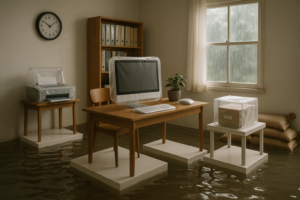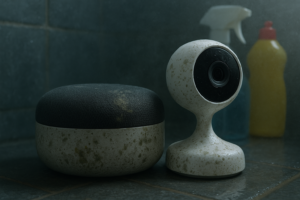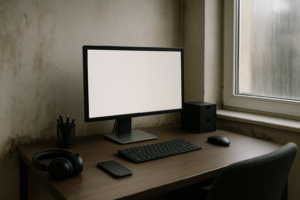If you’re the kind of person who treats your dog like your child or lets your cat rule the roost, you’re definitely not alone. Our furry companions are more than just pets — they’re part of the family. So when something goes wrong in the home, like a mold infestation or water damage, the conversation usually focuses on how it affects humans. But let’s not forget about our animal sidekicks who walk, crawl, hop, or slither through the same spaces we live in. This article breaks down how mold and water issues affect animals, what to watch out for, and how to make your house safe for your four-legged best friends during restoration work.
How Mold Can Affect Pets
When mold creeps into your space, it affects more than just the air quality; it can directly impact the health of your pets in a variety of ways. Dogs, cats, birds, rabbits, and other household animals have smaller and more sensitive respiratory systems than humans. What might just be a sniffle or sneeze for you can quickly become something a lot more serious for them.
Common pet reactions to mold exposure might include coughing, wheezing, and nasal discharge. You may notice changes in behavior like lethargy or appetite loss. These symptoms can be easy to overlook if you assume your pet is just under the weather, but in the presence of visible mold growth or a recent water event, it’s worth taking seriously.
Birds in particular are highly susceptible to airborne irritants and can develop severe respiratory issues from even mild mold spores. That’s not fear-mongering — it’s real. Think about how much closer your pets are to the ground where mold can grow on walls, in carpets, or baseboards. If they’re in constant contact with contaminated materials, the chances of health issues only increase.
Signs of Mold Exposure in Animals
No one expects their dog to come up and say, “Hey, I think there’s mold in the corner of the living room.” So it’s up to us to recognize the signals. If your home has recently been affected by water damage or has developed a strong musty odor, this could be a warning sign in itself.
Some of the more noticeable signs of mold exposure in pets include frequent paw licking, sneezing, coughing, excessive scratching, fur loss, and even digestive issues like vomiting or diarrhea. You might also notice red or irritated eyes or changes in mood. A playful animal suddenly becoming withdrawn is always worth a closer look, especially if it’s consistent.
In more severe cases, long-term exposure to mold can lead to chronic respiratory problems or infections that require veterinary care. Mold doesn’t just hang around in one spot either. It spreads through spores that travel through the air and into other areas of your home, exposing your pets on a continual basis.
How Water Damage Creates Mold Risks for Pets
A burst pipe, a leaking roof, or a neglected drip under the sink doesn’t just mean soggy drywall. It sets the stage for mold growth that can start within 24 to 48 hours of moisture exposure. That’s all it takes. If you think you can wait and deal with it later, that delay could put both you and your pets in harm’s way.
Animals spend time in places where most homeowners rarely go. Under beds, behind couches, or in basements — all high-risk areas when water damage hits. If these spots stay damp and unresolved, they become ideal breeding grounds for mold. Pets in these areas are breathing in spores daily, and most of us may not even know it’s happening.
Water damage also disrupts daily routines for pets. Relocations, loud equipment, unfamiliar smells, and strangers in the home can cause stress and behavioral shifts. That stress alone can make an already compromised pet more prone to illness.
Furry Safety Tips During Home Repairs
When addressing mold and water issues, it’s easy to get focused on tearing out drywall or setting up fans and dehumidifiers. But during that chaos, your pets are often left to navigate an unstable environment. Sudden environmental changes can frighten pets or even push them into dangerous areas.
To maintain safety for your animals during cleanup or repairs, here are some approaches that actually work. First, remove pets from affected areas completely. If you’re dealing with mold removal or major structural cleanups, relocate your pets to another room, a friend’s house, or even a pet boarding facility until it’s safe for them to return. This reduces stress and keeps them out of danger.
Use pet-safe cleaning products. Harsh chemicals can leave behind residues that irritate paws, skin, or airways. If your pet returns to a cleaned area too quickly, they can absorb or inhale residues left behind from strong disinfectants or bleaches. Stick to non-toxic products and confirm with your restoration team what’s being used if someone else is doing the work.
Make sure all windows and doors in affected areas are secure. During noisy or stressful repairs, pets may look for an escape route. That can spell disaster, especially for indoor-only animals. Use baby gates or barricades, or even keep them in crates if necessary just to prevent them from wandering where they shouldn’t.
When to Seek Veterinary Help
If you suspect your pet has been exposed to mold, don’t hesitate to call your vet. Waiting it out is not a strategy here. Mold-related illness can mimic other health issues, so a proper diagnosis is key. Bring up your home’s recent history of water damage or mold growth during the vet visit. That context helps them make faster, better decisions about treatment.
Veterinary treatment might involve antihistamines, anti-inflammatory medications, or antibiotics depending on how severe the symptoms are. Some pets may also need ongoing care if their lungs have been impacted. Birds, again, tend to need immediate treatment due to their extremely sensitive respiratory systems, so don’t put it off.
If you’ve got multiple pets and you suspect mold is the issue, it’s smart to book appointments for all of them. While one animal might show symptoms first, the others may still be carrying early exposure effects that just haven’t flared up yet. Better safe than sorry on this one.
Cleaning Up Mold While Keeping Pets Safe
Let’s be real — mold cleanups are messy, smelly, and time-consuming. But doing the job the right way matters even more when you’ve got animals. Keeping pets out of contaminated zones is step one. But there’s more you can do.
Always ventilate affected areas, but don’t assume that simply cracking a window will be enough. True mold remediation often stirs up spores, which can travel into other parts of the home. If you have to run air scrubbers or large fans, think about how that noise or air flow might stress your animals or blow spores toward the rooms they occupy. Use plastic sheeting to close off contaminated zones and run air purifiers in your living space if necessary.
If using mold-killing sprays, pay attention to drying times. Pets love to roll, rub, and sniff anything that smells new or different. They may come in contact with surfaces that are still chemically active. Don’t reintroduce pets into cleaned spaces until every inch is dry and aired out. That patience can save you from another trip to the vet.
Professional remediation services often provide better results than DIY efforts, not to mention guidance about pet safety throughout the process. Some restoration companies even offer containment solutions specifically for homeowners with pets. Ask about it when setting up an assessment. You’ll be glad you did.
Preventing Pet Exposure to Mold and Water Damage
You can’t always stop emergencies from happening, but you can put some safeguards in place that reduce risk when they do. First off, monitor common moisture-prone areas like the laundry room, around sinks, or basement walls. If your pets spend time in those areas, check for musty odors, discoloration, or signs of dampness.
Dehumidifiers can help keep moisture under control, especially in humid climates. If you live somewhere that deals with lots of rain or seasonal flooding, make use of moisture meters on floors and walls or have your home inspected regularly.
Consider adding pet-safe flooring in lower-level rooms. Carpets are mold’s best friend, especially after a leak or spill. Vinyl, tile, or sealed concrete options are easier to clean and less likely to harbor long-term moisture.
If remodeling or performing restoration works in your home, set up temporary safe zones. These can be as simple as a spare bedroom or sectioned-off area with clean air circulation, plenty of water, and their favorite toys. Keeping stress low also keeps their immune systems in better shape to handle any small exposures.
What to Do If Your Pet Has Already Been Exposed
Sometimes you only realize there’s a problem after your pet has already started showing symptoms. If mold is discovered in a place your dog or cat frequently sleeps or plays, start by isolating that area to prevent further exposure. Remove contaminated bedding, toys, or food bowls and do a deep cleaning using safe products.
After that, monitor your pet’s health closely. Note any breathing issues, energy changes, or skin irritation. Write things down too. Those notes can help a vet narrow down exposure timing and severity, speeding up treatments and avoiding unnecessary ones.
Also don’t underestimate the mental effect mold can have. Odd smells, disrupted schedules, and restricted space can all affect your pet’s mood and stress levels. You might deal with nervous behaviors like excessive barking, chewing, or hiding. Pets need time to adjust, just like people do.
Keeping the House Safe for All Species During Restoration
During major repair jobs, the temptation is to put pet concerns on the back burner. After all, you’ve got walls to tear down, floors to dry, and insurance calls to make. But the truth is, pets can suffer long after the damage is done if they’re left unprotected.
Work with your restoration team to set up barriers that keep pets out of work zones. Make sure your contractors know you have animals in the house so they’re aware of escape risks or noise levels. Ask which materials or solutions might be toxic and ask about their drying and off-gassing periods.
A little communication goes a long way here. If drying equipment is going to make nighttime rest for your dog impossible, create a sleep nook far away from the chaos. If the restoration work is making your cat too skittish to eat or use the litter box, consider temporary relocation just until the loudest parts of the job are over.
By thinking through how restoration affects all parts of your family, including furry ones, you make recovery faster and healthier for everyone involved.
Summary
Mold and water damage are no joke when it comes to protecting the well-being of our pets. Their smaller bodies, closer proximity to contaminated materials, and inability to communicate directly make them especially at risk. Watch for signs like breathing trouble, skin irritation, or behavioral shifts that could suggest exposure. During repairs, use containment, non-toxic products, and temporary relocation when needed. Your furry friends depend on you for a safe living space, so keep their needs at the front of your mind during both cleanup and prevention. Mold doesn’t just affect the humans in your house — it impacts the whole pack.







